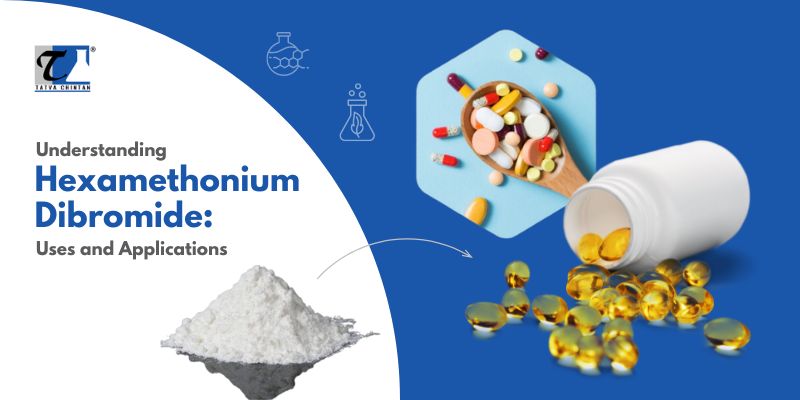Understanding Hexamethonium Dibromide: Uses and Applications
Hexamethonium dibromide is a quaternary ammonium compound that acts as a selective antagonist. It is a key chemical compound used as a structure-directing agent (SDA) in synthesizing zeolite. Due to its characteristics, hexamethonium dibromide has many applications which we will discuss in this article.
What is Hexamethonium Dibromide?
Hexamethonium dibromide is a quaternary ammonium compound used as an SDA in the synthesis of zeolites. As an SDA, it plays a crucial role in controlling the formation of zeolite structures during its synthesis. Zeolites are crystalline aluminosilicates with well-defined pore structures and are widely used in catalysis and adsorption applications.
Hexamethonium dibromide manufactured by Tatvan Chintan has a bulky structure and positively charged quaternary ammonium head group. The compound interacts with the growing zeolite framework during crystallization. Its use as an SDA in synthesizing zeolite makes it crucial for tailoring zeolite properties to meet specific industrial applications such as catalysis, ion exchange, and molecular sieving.
Uses And Applications of Hexamethonium Dibromide
Although hexamethonium dibromide's primary application is as a pharmaceutical agent, particularly as a ganglionic blocker, it still finds application as an SDA in zeolite synthesis. Zeolites are crystalline, microporous materials widely used in catalysis, adsorption, and ion exchange due to their regular pore structures and large surface areas.
The following are a few of the potential uses and applications of hexamethonium dibromide as an SDA for zeolites discussed in further detail.
Synthesis of Zeolites with Unique Pore Structures
Hexamethonium dibromide acts as an SDA that facilitates the creation of zeolites with specific pore diameters and structures. This capability helps create zeolites optimized for various uses, such as molecular sieves and catalysts.
Therefore, hexamethonium dibromide is a chemical compound that controls the formation of the crystal lattice structure of zeolites, making them a suitable material for the purposes for which they are intended. Thereby, their performance is improved when used across many industries and fields.
Controlled Pore Size Distribution
The pore size distribution of the zeolite can be controlled with great accuracy by varying the concentration of hexamethonium dibromide in the synthesis mixture. This ability is critical to achieve the desired properties of zeolites for numerous applications in various industries ranging from catalysis to adsorption, and ion exchange.
By optimizing pore size distribution, these materials can improve their selectivity and reactivity. Thus, they can be more effective in several technological applications while maintaining cost-effectiveness and performance.
Enhanced Catalytic Properties
By using hexamethonium dibromide as an SDA during zeolite synthesis, the resulting zeolites boast exceptional catalytic abilities. This stems from the precise control the SDA exerts over the formation of the zeolite's pore structure. Imagine these pores as tiny tunnels within the zeolite. By controlling their size and arrangement, the zeolite is tailored to interact specifically with desired molecules.
Note that this is a targeted design that makes these zeolites superior molecular sieves and catalysts. Moreover, it offers a significant advantage in fields like petrochemical refining and environmental cleanup. Generally, these zeolites contribute to cleaner and more efficient industrial operations.
Selective Adsorption Properties
Imagine zeolites as microscopic sponges with custom-sized holes. These holes, determined by the zeolite's structure, allow them to selectively capture specific molecules. Hexamethonium dibromide used during zeolite synthesis can act like a mold. It precisely controls the arrangement of these holes, allowing for the production of tailor-made zeolites for capturing desired molecules or ions from a mixture.
Additionally, this targeted adsorption makes them important in separation processes, efficiently purifying and isolating valuable substances based on their size and chemistry. From cleaning up pollutants to separating valuable chemicals in the petrochemical industry, hexamethonium dibromide-treated zeolites offer a versatile tool for various industrial applications.
Improved Stability and Durability
Zeolites synthesized using hexamethonium dibromide show a significant improvement in their ability to withstand tough environments. This translates to better performance and longer lifespans in industrial settings, where reliability is key.
By using this method, zeolites retain their structure and functionality for extended periods, making them a dependable choice for industrial applications. These tougher zeolites can endure harsh chemical and thermal conditions without sacrificing their effectiveness, leading to a more robust and long-lasting solution.
Ion Exchange Applications
Hexamethonium dibromide-modified zeolites are used in ion exchange procedures to selectively remove ions from aqueous or gaseous solutions. This property is particularly useful in a variety of applications, including water treatment and purification technologies, where zeolites can effectively remove impurities and enhance water quality.
This modified version of zeolite increases its affinity for certain ions, improving its efficiency in environmental remediation and industrial operations that reduce contaminants in both liquid and gas phases. The adaptability of hexamethonium dibromide-modified zeolites highlights their promise in a wide range of applications that require good ion exchange capabilities.
Environmental Applications
Zeolites produced with hexamethonium dibromide SDA show great promise in environmental applications. They are especially effective at removing pollutants from both air and water streams because of their large surface area and customizable pore patterns.
These qualities allow zeolites to act as effective adsorbents for a wide spectrum of pollutants, resulting in better environmental remediation efforts in a variety of locations and sectors.
Conclusion
Hexamethonium dibromide serves as a key SDA in zeolite synthesis. By directing pore size and structure, it tailors zeolites for specific applications. Generally, hexamethonium dibromide produced by Tatvan Chintan facilitates the production of zeolites that are highly versatile and effective.






Comments
Post a Comment